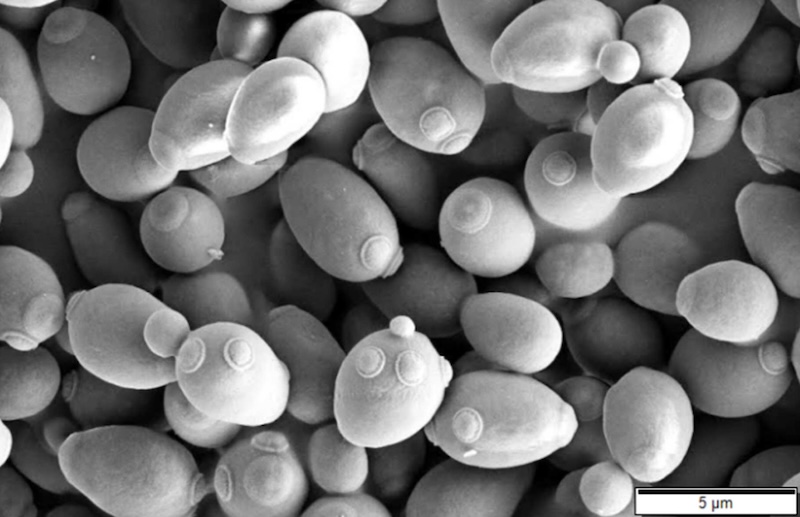Yeast on Mars could survive, unique new research shows
View larger. | Saccharomyces cerevisiae, also known as baker’s yeast. Could yeast survive on Mars? A new study from scientists in India shows how yeast on Mars could, in fact, tolerate the red planet’s harsh conditions. Image via Mogana Das Murtey/ Patchamuthu Ramasamy/ Wikimedia Commons (CC BY 3.0). Yeasts are single-celled microorganisms of the fungus kingdom. Could yeast survive on Mars? A new study from researchers in India shows that some of them would be able to. The yeast cells were exposed to high-intensity shockwaves and toxic perchlorate salts in lab tests. Many of them survived. Science matters. Wonder matters. You matter.Join our 2025 Donation Campaign today. Yeast on Mars When it comes to earthly organisms that could conceivably survive on Mars’ harsh surface, the options are seemingly few. But scientists in India found one that just might be able to: yeast. Researchers at the Indian Institute of Science (IISc) and the Physical Research Laboratory (PRL) said on October 24, 2025, that simple yeast cells could survive shockwaves from meteorite impacts and highly toxic perchlorate salts. The research team used simple baker’s yeast (Saccharomyces cerevisiae) for their experiments. Yeasts are tiny, single-celled microorganisms that are classified as part of the fungus kingdom. There are more than 1,500 species currently known. The researchers published their peer-reviewed findings in the journal PNAS Nexus on October 14, 2025. Shockwaves and salts To find out if yeast could actually survive the extreme conditions on Mars, the researchers exposed their yeast samples to two kinds of environmental factors. These were shock waves, mimicking meteorite impacts or marsquakes, and perchlorate salts, which are highly toxic and common on Mars. The shockwaves reached mach 5.6 in intensity. In addition, the researchers exposed the yeast cells to 100 mM sodium perchlorate. This was done both in isolation from the shockwaves and in combination with the shockwaves. These unique experiments had not been done before, explained lead author Riya Dhage, a project assistant at the Indian Institute of Science: One of the biggest hurdles was setting up the HISTA tube to expose live yeast cells to shock waves – something that has not been attempted before – and then recovering yeast with minimum contamination for downstream experiments. What makes this work unique is the integration of shock wave physics and chemical biology with molecular cell biology to probe how life might cope with such Mars-like stressors. Could life survive on Mars? Yeast offers a clue #EarthDotCom #EarthSnap #Earth — Earth.com (@earthdotcom.bsky.social) 2025-10-25T13:25:36Z Yeast on Mars survived in simulations Remarkably, many of the yeast cells did survive. Notably, this was the case whether they were tested with the shockwaves and perchlorates together or separately. The growth of the cells did slow down, but the stressful and toxic conditions didn’t kill them. Co-author Purusharth Rajyaguru said: We were surprised to observe yeast surviving the Mars-like stress conditions that we used in our experiments. We hope that this study will galvanize efforts to have yeast on board in future space explorations. So, how did they survive? The researchers said that ribonucleoprotein (RNP) condensates, produced by the cells, likely saved them. Those are tiny structures that have no membranes. They help protect and reorganize mRNA (messenger RNA) when the cells are under stress. mRNA is a type of single-stranded RNA (ribonucleic acid) involved in protein creation. In fact, the shockwaves triggered the creation of two types of RNPs, called stress granules and P-bodies. The perchlorates, meanwhile, caused the formation of just P-bodies. In some cases, however, the yeast cells weren’t able to form those structures. And consequently, those cells didn’t survive. View larger. | This image shows yeast cells with the protective RNP condensates in them (yellow dots). Image via Riya Dhage/ Indian Institute of Science. Lead author Riya Dhage and co-author Purusharth Rajyaguru at the Indian Institute of Science. Image via Swati Lamba/ Indian Institute of Science. Possible biosignatures The fact that many of the yeast cells did survive was surprising, and shows that similar kinds of cells could indeed survive on Mars in some instances. With that in mind, the protective RNP condensates might actually be good biosignatures – signs of life – when searching for evidence of extraterrestrial lifeforms. Dhage said: What makes this work unique is the integration of shock wave physics and chemical biology with molecular cell biology to probe how life might cope with such Mars-like stressors. Bottom line: A new study from scientists in India shows that yeast could survive on Mars, tolerating both shockwaves from impacts and toxic perchlorate salts. Source: Ribonucleoprotein (RNP) condensates modulate survival in response to Mars-like stress conditions Via Indian Institute of Science Read more: Life on Mars? Odd rings and spots tantalize scientists Read more: Prototaxites: Oldest giant organisms a lost kingdom of life?The post Yeast on Mars could survive, unique new research shows first appeared on EarthSky.
A new study from scientists in India shows that yeast could survive on Mars, tolerating both shockwaves from impacts and toxic perchlorate salts. The post Yeast on Mars could survive, unique new research shows first appeared on EarthSky.

- Yeasts are single-celled microorganisms of the fungus kingdom.
- Could yeast survive on Mars? A new study from researchers in India shows that some of them would be able to.
- The yeast cells were exposed to high-intensity shockwaves and toxic perchlorate salts in lab tests. Many of them survived.
Science matters. Wonder matters. You matter.
Join our 2025 Donation Campaign today.
Yeast on Mars
When it comes to earthly organisms that could conceivably survive on Mars’ harsh surface, the options are seemingly few. But scientists in India found one that just might be able to: yeast.
Researchers at the Indian Institute of Science (IISc) and the Physical Research Laboratory (PRL) said on October 24, 2025, that simple yeast cells could survive shockwaves from meteorite impacts and highly toxic perchlorate salts. The research team used simple baker’s yeast (Saccharomyces cerevisiae) for their experiments.
Yeasts are tiny, single-celled microorganisms that are classified as part of the fungus kingdom. There are more than 1,500 species currently known.
The researchers published their peer-reviewed findings in the journal PNAS Nexus on October 14, 2025.
Shockwaves and salts
To find out if yeast could actually survive the extreme conditions on Mars, the researchers exposed their yeast samples to two kinds of environmental factors. These were shock waves, mimicking meteorite impacts or marsquakes, and perchlorate salts, which are highly toxic and common on Mars.
The shockwaves reached mach 5.6 in intensity. In addition, the researchers exposed the yeast cells to 100 mM sodium perchlorate. This was done both in isolation from the shockwaves and in combination with the shockwaves.
These unique experiments had not been done before, explained lead author Riya Dhage, a project assistant at the Indian Institute of Science:
One of the biggest hurdles was setting up the HISTA tube to expose live yeast cells to shock waves – something that has not been attempted before – and then recovering yeast with minimum contamination for downstream experiments.
What makes this work unique is the integration of shock wave physics and chemical biology with molecular cell biology to probe how life might cope with such Mars-like stressors.
Could life survive on Mars? Yeast offers a clue #EarthDotCom #EarthSnap #Earth
Yeast on Mars survived in simulations
Remarkably, many of the yeast cells did survive. Notably, this was the case whether they were tested with the shockwaves and perchlorates together or separately. The growth of the cells did slow down, but the stressful and toxic conditions didn’t kill them. Co-author Purusharth Rajyaguru said:
We were surprised to observe yeast surviving the Mars-like stress conditions that we used in our experiments. We hope that this study will galvanize efforts to have yeast on board in future space explorations.
So, how did they survive? The researchers said that ribonucleoprotein (RNP) condensates, produced by the cells, likely saved them. Those are tiny structures that have no membranes. They help protect and reorganize mRNA (messenger RNA) when the cells are under stress. mRNA is a type of single-stranded RNA (ribonucleic acid) involved in protein creation. In fact, the shockwaves triggered the creation of two types of RNPs, called stress granules and P-bodies. The perchlorates, meanwhile, caused the formation of just P-bodies.
In some cases, however, the yeast cells weren’t able to form those structures. And consequently, those cells didn’t survive.


Possible biosignatures
The fact that many of the yeast cells did survive was surprising, and shows that similar kinds of cells could indeed survive on Mars in some instances. With that in mind, the protective RNP condensates might actually be good biosignatures – signs of life – when searching for evidence of extraterrestrial lifeforms. Dhage said:
What makes this work unique is the integration of shock wave physics and chemical biology with molecular cell biology to probe how life might cope with such Mars-like stressors.
Bottom line: A new study from scientists in India shows that yeast could survive on Mars, tolerating both shockwaves from impacts and toxic perchlorate salts.
Via Indian Institute of Science
Read more: Life on Mars? Odd rings and spots tantalize scientists
Read more: Prototaxites: Oldest giant organisms a lost kingdom of life?
The post Yeast on Mars could survive, unique new research shows first appeared on EarthSky.

